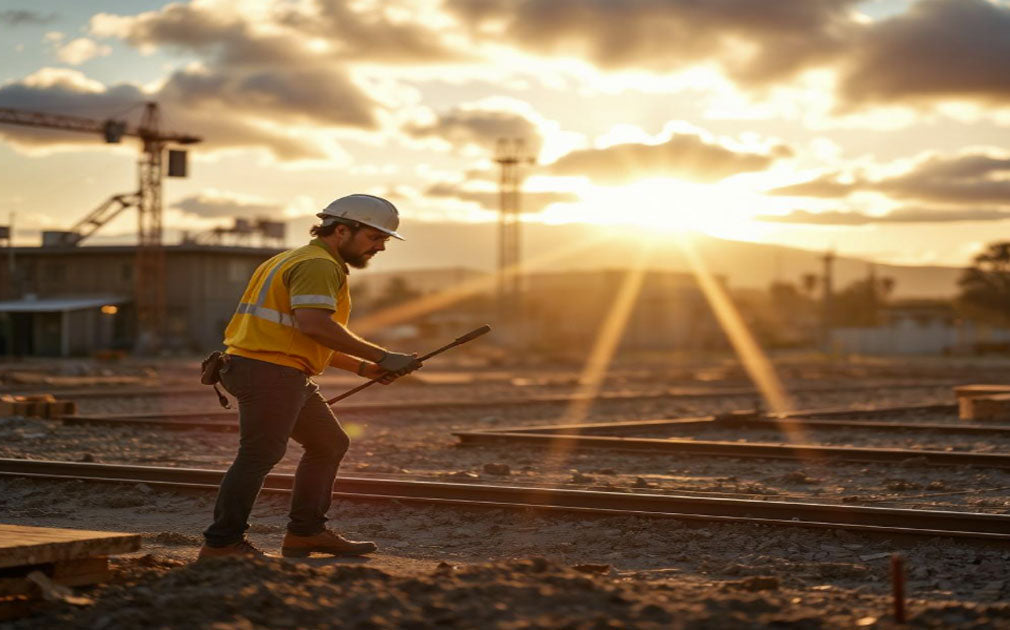Political Battleground: Labour's $78M Fast-Track vs Coalition's $260M Technical Colleges as Housing Affordability Takes Centre Stage
By CAQA Correspondents
Once again, housing affordability dominates an Australian federal election, with both major parties placing housing policies at the centre of their respective campaigns. As Australia faces its most severe construction skills shortage in decades, political leaders have unveiled ambitious plans to address the critical deficit of qualified tradespeople threatening to undermine the nation's housing goals. With the Housing Industry Association's recent skills mapping assessment revealing a staggering shortfall of over 83,000 trade workers needed to achieve Australia's 1.2 million new homes target, industry leaders are warning that without immediate intervention, housing targets will remain "a pipe dream" and the affordability crisis will only deepen.
THE DEVASTATING NUMBERS BEHIND AUSTRALIA'S TRADIE DROUGHT
The construction sector's workforce crisis has reached alarming proportions, with HIA's analysis pinpointing specific trade deficits: 22,000 carpenters, 17,000 electricians, 12,000 plumbers, 5,000 bricklayers, and 3,000 concreters are urgently needed across the country. "Put simply, if we don't have the tradies coming through, the 1.2 million homes target will be a pipe dream," warns HIA managing director Jocelyn Martin. The shortage spans the entire nation, with particularly acute deficits in high-growth areas including Perth, Brisbane, Adelaide, and regional Queensland, Western Australia, and South Australia.
The scale of this shortage cannot be overstated, with an astonishing 83% of construction companies now reporting difficulties finding skilled workers. This crisis is compounded by an aging workforce with many experienced tradespeople approaching retirement and insufficient new entrants to replace them. Despite accounting for 9% of Australia's entire workforce, an estimated 35% of construction workers lack formal qualifications, creating a vast pool of experienced but uncertified labour. The industry faces the daunting task of recruiting over 500,000 new workers in the next five years just to replace retirees and meet growing demand, while simultaneously addressing the alarming fact that almost half of the construction sector apprentices never complete their training.
LABOR'S $78 MILLION GAMBLE: FAST-TRACKING 6,000 TRADIES
In response to this crisis, Labor has announced a $78 million investment aimed at fast-tracking qualifications for 6,000 tradies if re-elected this year. The funding will establish the Advanced Entry Trades Training program, specifically designed to help underqualified workers secure the certifications they need. The initiative targets two key groups: current industry workers without formal apprenticeships and skilled migrants whose overseas qualifications remain unrecognised in Australia.
The program, slated to commence in 2026, will enable these workers to gain formal qualifications through recognition of prior learning and targeted training delivered by TAFEs and other Registered Training Organisations. This approach mirrors an existing program at the state level—the NSW government's Trade Pathways for Experienced Workers Program, which has seen 1,200 students earn qualifications in an average of just seven months instead of several years. This represents a dramatic improvement over traditional skill recognition processes, which, according to the Parkinson Review of Australia's migration system, can take up to 18 months for skilled migrants and cost over $9,000.
According to Master Builders Australia, each newly qualified tradie enables the construction of an additional 2.4 homes, meaning Labor's initiative could theoretically facilitate the building of 14,400 new homes. "When seeking to attract more skilled trades into Australia, it's crucial to also look at the talented individuals already here who are stuck in limbo because of an overly complex system. This funding will help remove those barriers," explains Master Builders Australia CEO Denita Wawn.
COALITION'S TECHNICAL COLLEGE REVOLUTION: $260 MILLION BET ON FUTURE TRADESPEOPLE
Not to be outdone, the Coalition has unveiled a $260 million plan to establish 12 Australian technical colleges across the country, with initial locations prioritising regions experiencing the most severe skills shortages. These specialist skills institutions will cater to students in years 10-12 or 11-12 who are enrolled in school-based apprenticeships or traineeships alongside academic courses leading to Year 12 certification.
This represents a substantial investment in developing Australia's future trade workforce through early intervention in the education system. The announcement complements the Coalition's broader housing agenda, which includes proposed mortgage tax deductions for first-home buyers purchasing new homes and plans to accelerate approvals for new housing projects.
While Master Builders Australia has welcomed the initiative, the organisation cautions that technical colleges must complement rather than replace existing vocational pathways. "Technical colleges play an important part of the skills education mix and support students in learning the necessary skills to start a career in building and construction, while not giving up the opportunity to attain the high school certificate," notes Wawn, adding that this approach "must not be at the expense of other measures like free VET."
BEYOND POLITICAL PROMISES: THE WIDER CRISIS FACING CONSTRUCTION
The political battle over trades training unfolds against a backdrop of persistent economic and productivity challenges that extend far beyond workforce shortages. Construction costs have surged by 7.7% over the past year, particularly for essential materials like timber, steel, and concrete, further exacerbating housing affordability concerns. These cost pressures, combined with the skills shortage, have created a perfect storm for the construction industry.
The Productivity Commission has highlighted stagnant productivity growth in housing construction as a key constraint on supply, with workforce limitations and complex regulations creating significant bottlenecks. Recent data illustrates the severity of the problem: while the government's housing targets require an average of 240,000 new homes annually, only 167,000 were completed in 2024, with projections suggesting an average of just 180,000 per year in the near future.
In Queensland, a stark example of the nationwide trend, only 36,147 homes were approved in the past year, falling significantly short of the state's target of 50,000 annually. Most regions are experiencing concerning declines in approval rates, further jeopardising national housing goals.
THE BUDGET BATTLEFIELD: COMPETING VISIONS FOR AUSTRALIA'S SKILLS FUTURE
The competing approaches to addressing the skills crisis extend into broader budget priorities. The Albanese Labor Government's 2024-25 Budget includes $90.6 million specifically targeted at boosting skilled workers in construction, with $88.8 million allocated for 20,000 additional Fee-Free TAFE training places and $62.4 million for 15,000 more Fee-Free TAFE and VET positions. Additionally, $26.4 million has been earmarked for approximately 5,000 pre-apprenticeship places, and $1.8 million for streamlining skills assessments for roughly 1,900 potential migrants.
The Coalition's broader approach includes significant incentives for employers and apprentices, offering up to $12,000 for businesses hiring new trainees or apprentices and $10,000 for construction apprentices through their Key Apprenticeship Program.
Despite these initiatives, industry leaders have criticised both major parties for insufficient focus on skilled migration, which many experts consider essential for rapidly addressing the current deficit. There are growing calls for comprehensive reform of Australia's skills recognition system, particularly for overseas-trained workers already in Australia who face lengthy, complex, and costly assessment processes that prevent them from practising their trades.
INNOVATION AS SALVATION: THE $900 MILLION PRODUCTIVITY GAMBIT
Recognising that workforce shortages represent just one dimension of the housing crisis, the 2025-26 Federal Budget includes a substantial $900 million National Productivity Fund. This fund allocates $120 million specifically to encourage the adoption of modern construction methods such as prefabrication and modular housing, with an additional $49.3 million to support related state programs.
These productivity measures aim to squeeze more output from the existing workforce through technological innovation and improved construction techniques. Additionally, efforts to develop national licensing for electrical trades and a voluntary certification process for off-site construction are underway, designed to enhance workforce mobility and productivity across state boundaries.
The National Skills Agreement now explicitly includes housing supply as a priority area, with BuildSkills Australia developing the country's first comprehensive workforce plan for the construction sector. This organisation is positioned to serve as a strategic voice for the construction, property, and water industries, potentially providing more coordinated responses to workforce challenges.
THE ROAD AHEAD: CAN AUSTRALIA BRIDGE THE GAP?
As the federal election approaches, the competing approaches to resolving Australia's construction skills crisis highlight fundamentally different philosophies about workforce development. Labor's focus on rapidly qualifying existing workers through recognition of prior learning offers a potential short-term solution, leveraging the considerable skills already present in the unqualified workforce. In contrast, the Coalition's technical colleges represent a longer-term investment in developing future generations of tradespeople through the education system.
Industry experts suggest that neither approach alone will be sufficient to address the magnitude of the current crisis. Research into recognition of prior learning for the construction sector apprentices reveals concerning institutional resistance to fast-tracking training—about 64% of assessed apprentices had prior experience and skills, but only 30% had their training shortened. These challenges become even more complex when considering accelerated pathways for skilled migrants, with significant documented difficulties in transferring or recognising vocational qualifications across international boundaries.
The systemic problems extend beyond workforce shortages. Australia's housing construction sector has experienced alarming productivity declines, with productivity halving over the last 30 years. This decline isn't solely attributable to labour shortages but also stems from complex planning approvals, limited innovation, and the predominance of small firms. Rising construction material costs and shortages further compound these challenges, placing additional pressure on an already strained industry.
With average salaries for tradespeople hovering around $70,000-$75,000 despite the critical shortage, questions remain about whether the financial incentives are sufficient to attract and retain talent in an increasingly competitive global market for skilled workers. Rising living costs and mortgage rates, which have increased by 18.9% over the past year, further complicate efforts to make trades careers attractive to new entrants.
As Australia faces this unprecedented skills challenge, the outcome of the upcoming federal election will significantly influence the nation's approach to workforce development in the construction sector. However, regardless of which party prevails, industry leaders emphasise that meeting the 1.2 million homes target will require unprecedented cooperation between government, industry, and educational institutions. Without such coordinated action spanning training, migration, innovation, and regulatory reform, Australia's ambitious housing goals may indeed remain, in the words of the HIA, "a pipe dream."


































